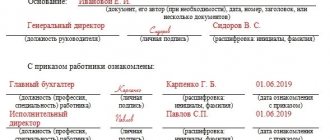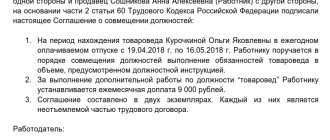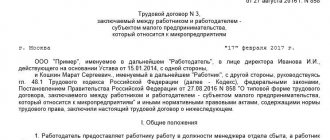Additional payment for a temporarily absent employee: general provisions
Additional payment for temporarily absent employee
The right to an employee to receive additional payment for performing the work duties of another employee during the period of his absence is enshrined in Labor legislation. The surcharge is accrued if the following conditions are simultaneously met:
- one of the employees is temporarily absent from work due to vacation, illness, or other reasons, in connection with which his job duties are performed by another employee;
- an employee replacing a temporarily absent employee is not exempt from performing his own job duties as provided for in the job description.
Replacing a temporarily absent employee implies an expansion of the work responsibilities and area of responsibility of the replacement employee, without increasing the length of the working day (work shift).
Calculation
- Several employees are allowed to hold one position. Then the total number of additional payments should not exceed 100% of the rate for this position.
- Taking into account the provisions of Art. 151 of the Labor Code of the Russian Federation, one employee can combine several professions. There are no standardizations for additional payments for combinations. The valid amount will be the amount indicated in the matching order.
- Persons belonging to the management team can combine positions and receive compensation.
Labor legislation allows additional work activity for those working citizens who want to get a part-time job and increase their monthly income. There are two main types of such activities - part-time and combination.
Combination usually means three types of work functions: temporarily replacing an absent colleague, expanding the area of responsibility (the employee is busy with additional work in his own profession) or classic combination (performing duties in two professions at once - his own and those related to the vacancy).
This is important to know: Is smoking on the balcony prohibited and what to do if neighbors smoke on the balcony
In all of these cases, the employee copes with additional responsibilities without interrupting his main activity, that is, during working hours limited to one shift.
The legislative framework
The procedure for determining the amount of additional payment to an employee when replacing an absent employee is enshrined in the Labor Code of the Russian Federation:
| No. | Regulatory document | Description |
| 1 | Art. 151 Labor Code of the Russian Federation | This provision of the Labor Code confirms the employee’s right to receive additional payment for a temporarily absent employee in the following cases:
The amount of additional payment for the replacement period is established by agreement of the parties and in accordance with the nature and volume of additional work. |
| 2 | Art. 60.2 Labor Code of the Russian Federation | The regulatory document defines the concept of additional work, for which an additional payment is charged in accordance with the established procedure. Also, this provision of the Labor Code of the Russian Federation describes the procedure for early refusal to perform additional work on the part of a replacement employee, as well as at the initiative of the employer. |
What does the Labor Code of the Russian Federation say?
The Labor Code of the Russian Federation states that if a person works in place of an absent colleague, he is provided with additional payment (Article 151 of the Labor Code of the Russian Federation). In practice, replacement occurs for various reasons, for example:
- the person is sick;
- a person’s stay on vacation: basic, educational;
- business trip;
- removal from official duties;
- the absent citizen assumed duties of a public and state nature.
If a person does his job and has a workload in the form of duties that are usually performed by a colleague, then an additional payment is established. This is an additional reward that is provided for the combination: it can be quite long in duration. Therefore, the payment algorithm for hired labor in this mode is usually agreed upon in a special document: it acts as an annex to the employment contract.
An employee, if he understands that he has taken a heavy load on his shoulders, may not accept it. But with 3 days notice to the boss. And also the manager has the right to cancel his order.
How is additional payment calculated for a temporarily absent employee?
In accordance with the Labor Code of the Russian Federation, additional payment for a temporarily absent employee is accrued by agreement of the parties - the employer and the employee assigned to perform additional work. Thus, the amount of the surcharge and the procedure for its calculation can be fixed in:
- employment contract;
- collective agreement;
- The procedure for remuneration, or other documents regulating the mechanism for calculating and calculating wages and other monetary remunerations at the enterprise.
The amount of additional payment for performing the duties of a temporarily absent employee can be calculated either in a fixed form (the so-called “flat rate”) or as a percentage of the salary . Below we will look at the procedure for calculating surcharges for each method and look at an example.
Firm bet
At many enterprises, additional payment for a temporarily absent employee is calculated in a fixed form, namely in fixed monetary terms. In this case, the additional payment does not depend on the income of the absent or replacement employee, but is paid in the amount established by the employment/collective agreement.
In the case of an additional payment at a fixed rate, organizations use a gradational approach to determining the amount of payment in accordance with the complexity of the work performed, its volume, and level of responsibility. In other words, the amount of payment is set in different amounts, depending on the position of the replacing (absent) employee.
In addition, in large companies and large manufacturing enterprises with a complex and branched organizational structure, the amount of additional payment is fixed separately for each structural unit.
How does the surcharge work?
According to Part 2 of Art. 151 of the Labor Code of the Russian Federation, the amount of additional payment for additional work is determined by agreement of the parties. When determining the amount, the employer must take into account:
- content and (or) scope of duties performed (Article 151 of the Labor Code of the Russian Federation);
- qualifications of the employee, complexity and conditions of the work performed, quantity and quality of labor expended (Article 129, Article 132 of the Labor Code of the Russian Federation);
- the employer’s obligation to provide equal pay for work of equal value (paragraph 6, part 2, article 22 of the Labor Code of the Russian Federation).
The Labor Code of the Russian Federation does not define either the minimum or maximum amount, but as an example of additional payment for additional work, use:
- the agreed amount of money;
- interest on the employee’s salary / tariff rate.
All payments are made officially with the execution of the relevant documents. Any discrimination in establishing and changing wage conditions is prohibited.
How to apply for additional payment for performing the duties of a temporarily absent employee
Below are step-by-step instructions for registering and calculating additional payments to an employee for performing the duties of a temporarily absent employee:
Step 1. Obtaining verbal consent from the employee
Before starting paperwork, you should obtain verbal consent from the employee to perform the duties of another employee during his absence. As a rule, at the initial stage, the employee’s immediate supervisor conducts a conversation with the subordinate, informing him of the need for a replacement (vacation, illness of another employee, other reasons) and obtaining consent or a reasoned refusal from the employee.
We emphasize that the manager does not have the right to force an employee to perform the duties of an absent employee. This decision is made solely by agreement of both parties - the employee and the company (represented by the manager).
Step-2. Drawing up an application
If the employee agrees to perform the duties of the absent employee, the manager invites him to fill out a corresponding application. There is no legally established form on which this application must be filled out, so the document can be drawn up in free form, indicating the required details:
- name of the organization;
- Full name, position of the absent and replacement employee;
- period of replacement of duties;
- reason for replacement (vacation, illness, other reasons);
- date of application, signature of the applicant.
A sample application can be downloaded here ⇒ Application to replace a temporarily absent employee (sample).
Step-3. Issuance of an order
A statement drawn up by the replacement employee and agreed upon by the manager is the basis for issuing the corresponding order. A sample order can be downloaded here ⇒Order to replace a temporarily absent employee (sample) .
Step-4. Accrual of surcharge
Based on the order, additional payments are calculated and accrued for the period of replacement of the absent employee and the performance of his job duties by the replacement employee.
Calculation of additional payments and payment of funds is carried out in accordance with the procedure and in the amount approved by the labor/collective agreement and internal regulations. As a rule, the employee is paid based on the results of the reporting month - along with the salary, the employee receives an additional payment for replacement.
Combination restrictions
The code does not contain information about restrictions on combining positions. Almost any employee in an organization can be assigned this type of work. There are two important factors to consider:
Any combination must be included in working hours, and not in excess of its norm.
It is advisable to combine positions of similar professions or employee qualifications. This is due to more competent performance of duties without wasting time on training.
However, we should not forget about the privileged category of citizens: pregnant women, disabled people, minor employees and mothers with children under three years of age. Although the law does not prohibit them from increasing the load, it is better to insure against unpleasant consequences.
This is important to know: Order to amend the order: sample 2021
To do this, you can discuss all working conditions, assess their applicability to these individuals and sign all the necessary documents.
Early refusal to perform the work of a temporarily absent employee
The current legislation enshrines the right of an employee to early refuse to replace an absent employee. To do this, the replacement should fill out a corresponding application and submit it to the manager no later than 3 days before the date of refusal to replace. For example, an employee who submitted an application on 06/18/18 may not perform absentee duties three days later, from 06/21/18.
A similar right is granted to the employer, who can notify the employee 3 days in advance of the early termination of replacement functions.
Writing examples
A sample application to perform duties during vacation looks like this:
Director of LLC "Standard"
In connection with the next annual leave of the chief accountant Ivanova I.A. from 07/19/2019 to 08/16/2019, I ask you to assign me the duties of the position of chief accountant from 07/19/2019 to 08/16/2019.
I have read and agree to the working conditions.
Accountant Smirnova E.N.
After drawing up the application, the employee gives the document to the manager, on the basis of which an order is issued.
In any organization, people go on vacation, sick leave, go on business trips or for training. Therefore, there is often a need to replace one specialist with another.
Which replacement method should the employer choose: combining positions, increasing the volume of work or temporary replacement? How to formalize the completion of such work and establish additional payment for it? Is it possible not to pay for it at all?
Step 1. Decide on the method of temporary performance of duties
The Labor Code provides for three ways for an employee to perform additional work without being released from the main one: combining positions (professions), increasing the volume of work (expanding service areas), and also performing the duties of a temporarily absent employee (Article 60.2 of the Labor Code of the Russian Federation).
The named methods are united by the fact that additional duties are carried out without interruption from the main job and during the established duration of working hours (shift) (part one of Art.
60.2 of the Labor Code of the Russian Federation). If such work is performed outside the working day, then it will be an internal part-time job (Art.
60.1, part one, art.
282 of the Labor Code of the Russian Federation). The employer’s choice of the form of performance of additional duties depends on the nature of the work.
In this case, it is necessary to take into account the features of each method.
Expert opinion
Gusev Pavel Petrovich
Lawyer with 8 years of experience. Specialization: family law. Has experience in defense in court.
Combining positions (professions) is the performance by an employee of additional work in another position (profession) (part two of Art.
60.2 of the Labor Code of the Russian Federation). An employee cannot combine positions of the same name.
Most often, combination is established when a staff position in an organization is not filled (vacant) for some reason. For example, a secretary, along with his work, can temporarily perform the labor function of a resigned personnel officer on a part-time basis until a new employee is hired for this position.
Attention! An employee may refuse to perform additional work ahead of schedule by notifying the employer in writing no later than three working days in advance (part four of Article 60.2 of the Labor Code of the Russian Federation)
An increase in the volume of work (expansion of service areas) is the performance by an employee of additional work in the same profession, but in an amount exceeding that established by the employment contract (part two of Art.
60.2 of the Labor Code of the Russian Federation). For example, if a cleaner, working at one rate, must clean 80 sq.
m of space, then, as part of an increase in the volume of work, she can be instructed to clean an additional 20 square meters. m during her main working hours.
Of course, if she is able to cope with such a volume.
Fulfilling the duties of a temporarily absent employee is the performance by an employee of additional work in the same profession or in another (part two of Art.
60.2 of the Labor Code of the Russian Federation). In this case, it is assumed that the replaced employee continues to be registered in the organization, but for some reason is not able to fulfill his duties.
In other words, temporary replacement is allowed only for occupied positions and is not allowed for vacant ones. So, an engineer can temporarily perform the duties of a supply manager while he is on sick leave.
Attention! If the position that the employee will temporarily fill involves direct servicing of material assets, enter into an agreement with him on full financial responsibility (Article 244 of the Labor Code of the Russian Federation, Resolution of the Ministry of Labor of Russia dated December 31, 2002 No. 85)
It must be borne in mind that if an acting employee is released from his main job, then this is a temporary transfer to another job (part one of Article 72.2 of the Labor Code of the Russian Federation).
Step 2. Obtain written consent from the employee
Additional work on the terms of combining, fulfilling the duties of a temporarily absent employee or increasing the volume of work can be assigned to the employee only with his written consent (part one of Art.
60.2 of the Labor Code of the Russian Federation). It can be expressed in an employee’s statement or formalized in a proposal for combination (increasing the volume of work, temporary replacement).
Step 3. We conclude an additional agreement to the employment contract
After receiving the employee’s consent, you need to draw up an additional agreement to his employment contract (part three of Art.
60.2 of the Labor Code of the Russian Federation). It must indicate: the name of the position for which additional work will be performed, its content and volume; the amount of additional payment for combining positions (increasing the volume of work, temporary replacement); the period during which the employee will perform additional work.
If the combination of professions is due to the presence of a vacant position in the organization, then the term of work in the additional agreement can be formulated as follows: “The employee is entrusted with performing the duties of an accountant in the order of combining positions with an additional payment of 40 percent of the salary for the combined position from April 7, 2014 until the closure vacant position."
When performing the duties of a temporarily absent employee, when it is impossible to accurately determine the moment of his return to work, the additional agreement with the replacement employee can indicate: “The employee is entrusted with performing the duties of an accountant in the order of combining positions with an additional payment of 40 percent of the salary for the combined position from April 7, 2014 until the absent employee returns to work.”
Attention! If the manager does not formalize or pay for additional work in any way, he may be held administratively liable in the form of a fine of 1,000 to 5,000 rubles (Article 5.27 of the Code of Administrative Offenses of the Russian Federation)
Step 4. We issue an order for the temporary performance of additional duties
Based on the concluded agreement, issue an order for the temporary performance of additional duties (sample below). The document must indicate the work being assigned, the deadline for its completion and the terms of payment. Familiarize yourself with the employee’s order against signature (paragraph 10, part two, article 22 of the Labor Code of the Russian Federation).
Step 5. Set the surcharge
Despite the fact that labor legislation does not establish minimum and maximum amounts of additional payment for the temporary performance of additional duties, the employee must be paid for this work. The amount of additional payment is determined by agreement of the parties and depends on the volume and content of additional work (Part.
second st. 151 Labor Code of the Russian Federation).
At the same time, the employer must remember his obligation to provide equal pay for work of equal value (paragraph 6 of Part.
second st. 22 Labor Code of the Russian Federation).
The surcharge can be set either as a fixed monetary amount or as a percentage of the tariff rate (salary) or the employee’s salary.
Remember the main thing
Says: Larisa Gordeeva – head of the personnel department of LLC “Personal-Group T” (Tomsk):
– Temporary performance of additional duties without release from the main job is possible in three forms: combining positions (professions), increasing the volume of work (expanding service areas), as well as performing the duties of a temporarily absent employee. When combining positions, the employee performs additional work in another position; in case of temporary replacement, both in the same profession and in another.
An increase in the volume of work involves working in the same position, but on a larger scale.
Ivan Uteshev – legal consultant of the Energogarant Insurance Joint Stock Company (Moscow):
– The employer must properly formalize and pay the employee for additional work. To do this, it is necessary to obtain the written consent of the employee, draw up an additional agreement to the employment contract and issue an order in any form.
There is no need to make an entry in the work book about the temporary performance of additional duties, but this information can be entered into your personal card.
Expert opinion
Gusev Pavel Petrovich
Lawyer with 8 years of experience. Specialization: family law. Has experience in defense in court.
Milana Dubrovskaya – head of HR administration and personnel settlements practice at Adolex LLC (Moscow):
– The additional agreement to the employment contract must contain the following mandatory conditions: the method of assigning responsibilities to the employee to perform additional work (combining or expanding the service area, increasing the volume of work), a list of assigned work. And also the period during which the employee will perform it, the amount of additional payment.
The departure of a key employee on vacation always has a negative impact on the activities of the enterprise. To eliminate or minimize costs, the company can hire another person to perform his duties during the absence of the main employee.
Dear readers! The article talks about typical ways to resolve legal issues, but each case is individual. If you want to find out how to solve your particular problem , contact a consultant:
APPLICATIONS AND CALLS ARE ACCEPTED 24/7 and 7 days a week.
It's fast and FREE !
To do this, you need to conclude an employment contract. It must specify all the conditions and work, the execution of which is mandatory.
How to remove additional payment for increasing the volume of work?
To remove the additional payment, you need to remove the employee’s responsibilities for performing the assigned work. The manager needs to issue an order to stop accrual of remuneration. Based on this document, the accounting department stops payments.
IMPORTANT! The increase in the scope of work can be stopped after the deadline for its introduction has expired. For example, an employee is assigned additional responsibilities for the period from June 1 to June 20. Payments stop on June 21. The manager must draw up an order in any case.
The increase in the scope of work may be terminated early. The formalization of this depends on whose initiative the termination of the previous agreement occurred. If this is the initiative of the worker, then a statement is drawn up, if the initiative of the employer is a notification, which must be familiarized to the employee against signature. The document is sent to the interested party three days before the load is reduced. For example, if it is expected that the employee’s duties will be removed on July 23, the application must be sent on July 20.









